Kaysie
Site Contributor
- Joined
- Mar 10, 2003
- Messages
- 14,464
- Reaction score
- 112
- Points
- 0
- Location
- North Dakota
- Country
- United States
- Display Name
- Kaysie
I know lately many people have been asking how to do salt baths. Since I'm in the midst of giving a poorly axolotl salt baths myself, I thought I would create this photo tutorial for you all.
This seems to me the most efficient way of doing salt baths, without a lot of wasted time between steps. Nice if you're busy like me! If you have any questions, please ask! An article on how to fridge your axolotl can be found here.
First, here's our beautiful little subject. She's a 5 or 6 year old eyeless axolotl. You can see the fungus on her gill stalk. As a note: this axolotl is eyeless, and therefore her container is not wrapped in a towel to prevent bright lights from startling her. If your axolotl has vision, please wrap their container in a towel when in the fridge.

Step 1.
Assuming your axolotl is kept in the fridge (which I recommend in conjunction with salt baths), take out your axolotl, the salt solution (which is kept in the orange bottle), and your dechlorinated water (on the top shelf, labeled here as 'salamander water' to keep the family from drinking it). All of these will be the same temperature. (Ignore the delicious leftover lasagna)
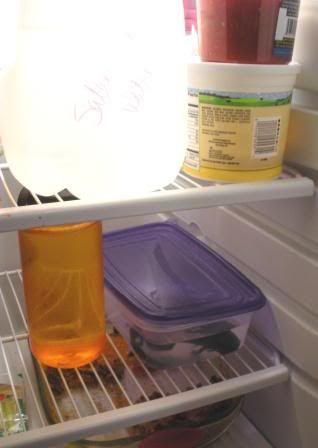
Step 2.
Collect your cast of characters on the counter/table. I don't recommend the stove, but that's where I had the best lighting. Here you will assemble your axolotl, dechlorinated water, salt bath solution, salt, and salt bath tub. Note the salt bath tub is labeled with an S, just to keep me from confusing the two.
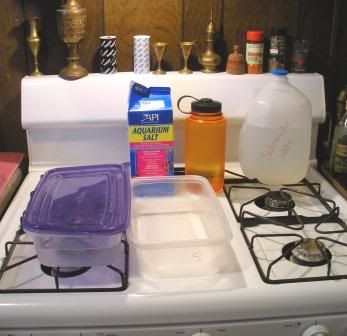
Step 3.
Pour the salt bath solution into the salt bath tub. I will show you how to make the salt bath solution a little later.
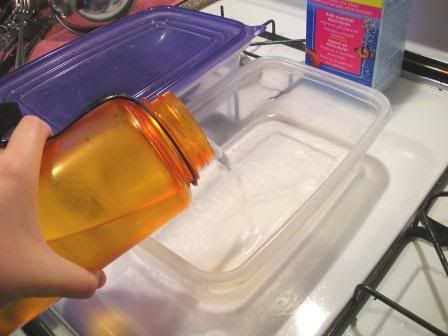
Step 4.
Gently move your axolotl from the dechlorinated tub to the salt bath tub. I do this by hand: grasp the axolotl firmly. I use one finger under the head, and three under the body, with the front legs in between. Have the salt bath tub right next to the dechlorinated one so you don't have to move it far.
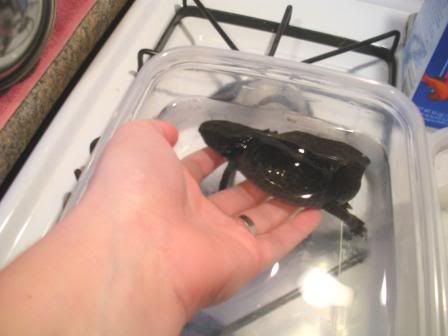
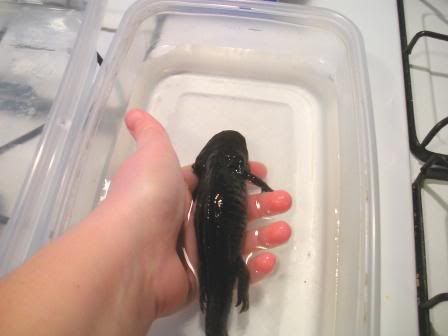
Step 5.
Set your timer for 10-15 minutes (maybe 20 if you're using a weak salt solution). In this case, I use my snazzy new microwave with its fancy kitchen timer. You can use whatever you want. Just make sure it's loud enough to hear so you don't forget! (And for the love of Pete, DO NOT MICROWAVE YOUR AXOLOTL!!)

Step 6.
Note this step does not need to be done every time you do a salt bath, but it must be done at least once a day. I do it in the morning.
Dump out the water from the dechlorinated tub. I usually rub it clean to remove any gunk, and rinse in hot water.

Step 7.
Fill your 1 liter container with dechlorinated water from the container you pulled from the fridge. Make sure you have enough to fill the tub to put the axolotl back in.

Step 8.
Fill the dechlorinated tub with leftover dechlorinated water from the fridge.
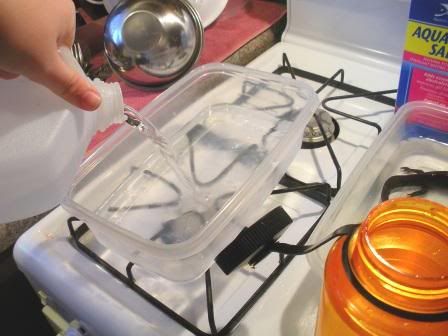
Step 9.
Mix your salt bath solution. Using the 1 liter container makes measuring this super-simple. I use a trusty ol' nalgene bottle. Mix your solution at 2-3 teaspoons per liter. As for the types of salt used: any non-iodized salt is fine. Don't use the 'low sodium' salts; those just replace sodium with potassium. I use aquarium salt, but rock salt, sea salt, or non-iodized table salt will be fine. Just note if you use a finer grain salt, you'll have more salt per teaspoon. That is, big grains of salt take up more space, so there's more air-space per teaspoon. To counter this, I use two and a partial teaspoon of aquarium salt.

Shake this solution up to dissolve the salt. Some of the salt may not dissolve right away, but that's okay. Dissolve what you can and stick it in the fridge. The rest will dissolve before you are ready for the next salt bath. Just shake it up really well before you do the salt bath.
Step 10.
Refill your water jug with dechlorinated water. Put it in the fridge.
Step 11.
Put your axolotl in the dechlorinated tub after the timer goes off. Put your axolotl in the fridge.
Now you should have salt bath solution, dechlorinated water, and your axolotl in the fridge. In 12 hours, repeat the process. Continue salt baths until the fungus disappears, and then for 2 or 3 days afterward, for good measure.
This seems to me the most efficient way of doing salt baths, without a lot of wasted time between steps. Nice if you're busy like me! If you have any questions, please ask! An article on how to fridge your axolotl can be found here.
First, here's our beautiful little subject. She's a 5 or 6 year old eyeless axolotl. You can see the fungus on her gill stalk. As a note: this axolotl is eyeless, and therefore her container is not wrapped in a towel to prevent bright lights from startling her. If your axolotl has vision, please wrap their container in a towel when in the fridge.

Step 1.
Assuming your axolotl is kept in the fridge (which I recommend in conjunction with salt baths), take out your axolotl, the salt solution (which is kept in the orange bottle), and your dechlorinated water (on the top shelf, labeled here as 'salamander water' to keep the family from drinking it). All of these will be the same temperature. (Ignore the delicious leftover lasagna)

Step 2.
Collect your cast of characters on the counter/table. I don't recommend the stove, but that's where I had the best lighting. Here you will assemble your axolotl, dechlorinated water, salt bath solution, salt, and salt bath tub. Note the salt bath tub is labeled with an S, just to keep me from confusing the two.

Step 3.
Pour the salt bath solution into the salt bath tub. I will show you how to make the salt bath solution a little later.

Step 4.
Gently move your axolotl from the dechlorinated tub to the salt bath tub. I do this by hand: grasp the axolotl firmly. I use one finger under the head, and three under the body, with the front legs in between. Have the salt bath tub right next to the dechlorinated one so you don't have to move it far.


Step 5.
Set your timer for 10-15 minutes (maybe 20 if you're using a weak salt solution). In this case, I use my snazzy new microwave with its fancy kitchen timer. You can use whatever you want. Just make sure it's loud enough to hear so you don't forget! (And for the love of Pete, DO NOT MICROWAVE YOUR AXOLOTL!!)

Step 6.
Note this step does not need to be done every time you do a salt bath, but it must be done at least once a day. I do it in the morning.
Dump out the water from the dechlorinated tub. I usually rub it clean to remove any gunk, and rinse in hot water.

Step 7.
Fill your 1 liter container with dechlorinated water from the container you pulled from the fridge. Make sure you have enough to fill the tub to put the axolotl back in.

Step 8.
Fill the dechlorinated tub with leftover dechlorinated water from the fridge.

Step 9.
Mix your salt bath solution. Using the 1 liter container makes measuring this super-simple. I use a trusty ol' nalgene bottle. Mix your solution at 2-3 teaspoons per liter. As for the types of salt used: any non-iodized salt is fine. Don't use the 'low sodium' salts; those just replace sodium with potassium. I use aquarium salt, but rock salt, sea salt, or non-iodized table salt will be fine. Just note if you use a finer grain salt, you'll have more salt per teaspoon. That is, big grains of salt take up more space, so there's more air-space per teaspoon. To counter this, I use two and a partial teaspoon of aquarium salt.

Shake this solution up to dissolve the salt. Some of the salt may not dissolve right away, but that's okay. Dissolve what you can and stick it in the fridge. The rest will dissolve before you are ready for the next salt bath. Just shake it up really well before you do the salt bath.
Step 10.
Refill your water jug with dechlorinated water. Put it in the fridge.
Step 11.
Put your axolotl in the dechlorinated tub after the timer goes off. Put your axolotl in the fridge.
Now you should have salt bath solution, dechlorinated water, and your axolotl in the fridge. In 12 hours, repeat the process. Continue salt baths until the fungus disappears, and then for 2 or 3 days afterward, for good measure.
Last edited by a moderator:
